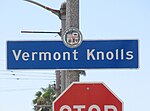Slauson station (J Line)

Slauson station is a busway station located in Los Angeles, California. It is situated between the 37th Street/USC and Manchester stations on the J Line, a bus rapid transit route which runs between El Monte, Downtown Los Angeles and San Pedro as part of the Metro Busway system. The station consists of two side platforms in the center of Interstate 110 above Slauson Avenue. The station serves the Vermont-Slauson, South Park and Florence neighborhoods of Los Angeles. Slauson station was built between 1989 and 1996 as part of the Harbor Transitway and opened to passengers on August 1, 1996. J Line buses serve the station twenty-four hours a day; the headway between buses is about four minutes during peak periods, with less frequent service at other times. Slauson station is also served by several Los Angeles Metro Bus and Torrance Transit bus services, most of which only run during weekday peak periods. An A Line station with an identical name is located approximately 2.1 miles (3.4 km) east of the station. Passengers may use LA Metro Bus route 108 to travel between the two.
Excerpt from the Wikipedia article Slauson station (J Line) (License: CC BY-SA 3.0, Authors, Images).Slauson station (J Line)
West Slauson Avenue, Los Angeles South Park
Geographical coordinates (GPS) Address Nearby Places Show on map
Geographical coordinates (GPS)
| Latitude | Longitude |
|---|---|
| N 33.98915 ° | E -118.28046 ° |
Address
West Slauson Avenue
West Slauson Avenue
90230 Los Angeles, South Park
California, United States
Open on Google Maps







